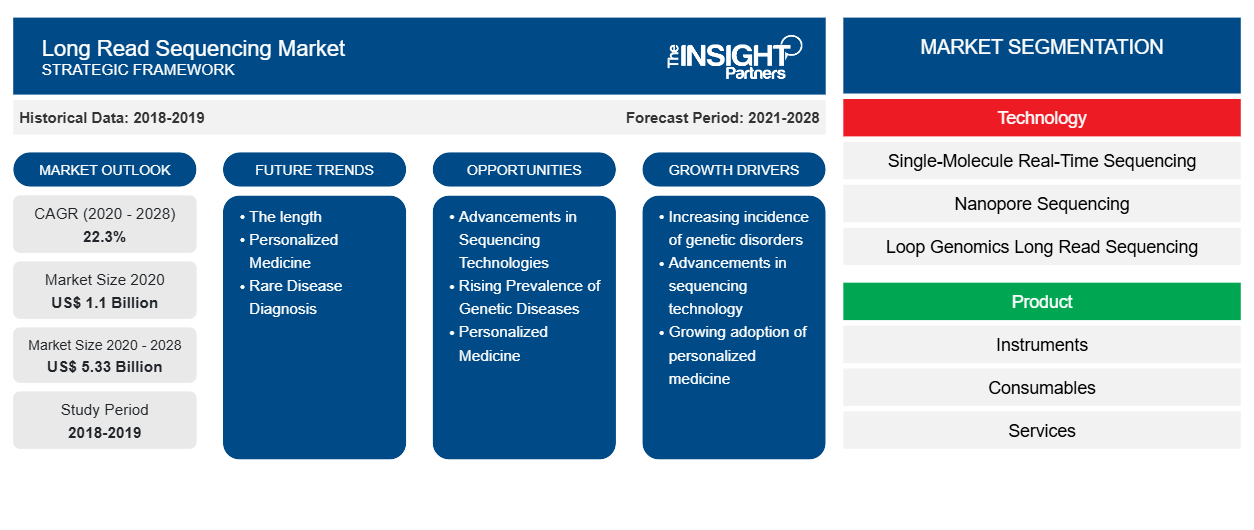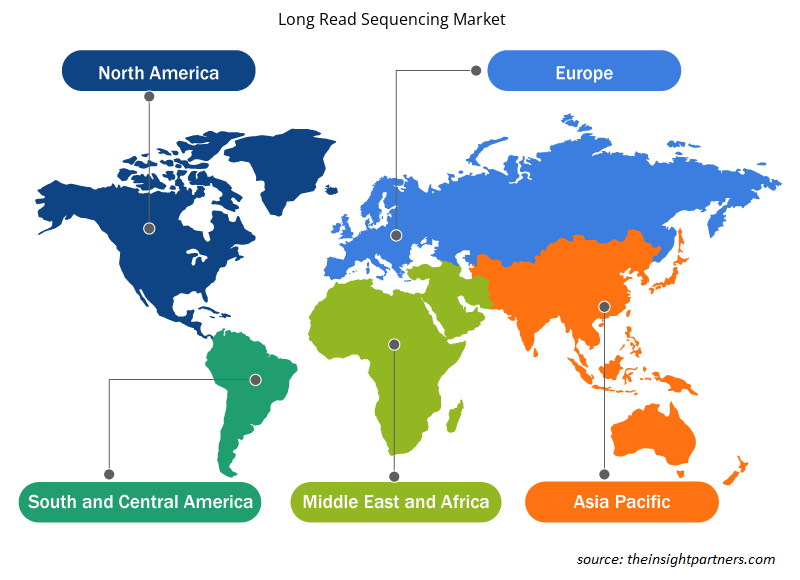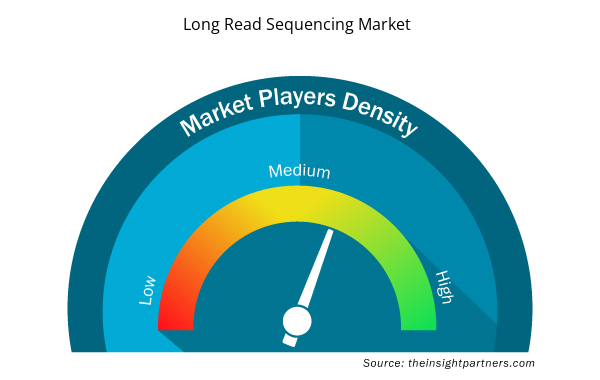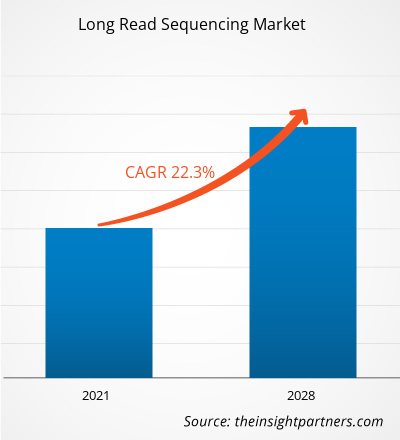The long read sequencing market was valued at US$ 1,101.15 million in 2020 and it is projected to reach US$ 5,334.68 million by 2028; it is expected to grow at a CAGR of 22.3% during 2021–2028.
The long read sequencing is a DNA sequencing technique. It offers numerous distinct advantages than next-generation sequencing technologies such as more precisely sequence DNA containing the same sections of DNA repeated within the genome. Many adults aged 60 years and above suffer from two or more chronic illnesses. Genes play a role in chronic diseases such as cardiovascular disease, diabetes, obesity, RA, Alzheimer's disease (AD), and depression, according to twin research. According to the Centers for Disease Control and Prevention (CDC), about 6 out of 10 individuals in the US are affected by at least one chronic disease, as well as 4 out of 10 are suffering from two or more chronic diseases. Furthermore, cancer is primarily caused by genomic errors. Researchers have analyzed cancer genomes using a variety of rapidly evolving sequencing technologies in order to better understand cancer cells' molecular status and expose their vulnerabilities such as driver mutations or gene expression. The researchers were able to recognize and classify new forms of cancerous mutations using long-read technologies, including complex structural variants in haplotype resolution. In recent years, several long read sequencing technologies have been developed and used. For example, Pacific Biosciences developed SMRT sequencing, which is one of the long read methods (PacBio). Long read sequencing is becoming more common, and cancer studies based on long read data are growing and advancing in order to decode complex cancer genomes.
Customize This Report To Suit Your Requirement
You will get customization on any report - free of charge - including parts of this report, or country-level analysis, Excel Data pack, as well as avail great offers and discounts for start-ups & universities
Long Read Sequencing Market: Strategic Insights

- Get Top Key Market Trends of this report.This FREE sample will include data analysis, ranging from market trends to estimates and forecasts.
Customize This Report To Suit Your Requirement
You will get customization on any report - free of charge - including parts of this report, or country-level analysis, Excel Data pack, as well as avail great offers and discounts for start-ups & universities
Long Read Sequencing Market: Strategic Insights

- Get Top Key Market Trends of this report.This FREE sample will include data analysis, ranging from market trends to estimates and forecasts.
Market Insights: Advantages of Long Read Sequencing Drives Long Read Sequencing Market
Long-read technologies are overcoming early limitations of accuracy and throughput and mounting their application in the fields of genomics. Long read sequencing or third-generation sequencing offers several advantages over short-read sequencing. While short-read sequencers such as Illumina’s HiSeq, NovaSeq, NextSeq, and MiSeq instruments, BGI’s MGISEQ and BGISEQ models; or Thermo Fisher’s Ion Torrent sequencers produce reads of up to 600 bases, long read sequencing technologies regularly generate reads over 10 kb Further, long reads can improve de novo assembly, mapping certainty, transcript isoform identification, and detection of structural variants. Also, long read sequencing of native molecules, i.e., DNA and RNA eliminates amplification bias while preserving base modifications. With continuing progress in accuracy, throughput, and cost reduction, these capabilities have begun to make long read sequencing an option for a broad range of applications in genomics for model and non-model organisms.
Technology:Insights
The global long read sequencing market, based on technology, is segmented into single-molecule real time sequencing (SMRT), nanopore sequencing, and loop genomics long read sequencing. The single-molecule real time sequencing (SMRT) segment held the largest share of the market in 2020. However, the loop genomics long read sequencing segment is expected to register the highest CAGR in the market during the forecast period.
Product:Based on product, the global long read sequencing market is segmented into instruments, consumables, and services. The instruments segment held the largest share of the market in 2020, and the services segment is expected to register the highest CAGR during 2021–2028.
Application:Based on application, the global long read sequencing market is segmented into identification and fine mapping of structural variation, tandem repeat sequencing, pseudogene discrimination, resolving allele phasing, reproductive genomics, cancer, viral and microbial sequencing, and others. The identification and fine mapping of structural variation segment held the largest share of the market in 2020, and the cancer segment is expected to register the highest CAGR from 2021 to 2028.
Workflow:Based on workflow, the global long read sequencing market is segmented into pre-sequencing, sequencing, and data analysis. The sequencing segment held the largest share of the market in 2020, and the same segment is expected to register the highest CAGR during 2021–2028.
End-User:Based on end-user, the global long read sequencing market is segmented into academic research institutes, hospitals and clinics, and pharma and biotechnology companies. The academic research institutes segment held the largest share of the market in 2020, and the same segment is expected to register the highest CAGR during 2021–2028.
Long Read Sequencing Market Regional Insights
The regional trends and factors influencing the Long Read Sequencing Market throughout the forecast period have been thoroughly explained by the analysts at Insight Partners. This section also discusses Long Read Sequencing Market segments and geography across North America, Europe, Asia Pacific, Middle East and Africa, and South and Central America.

- Get the Regional Specific Data for Long Read Sequencing Market
Long Read Sequencing Market Report Scope
| Report Attribute | Details |
|---|---|
| Market size in 2020 | US$ 1.1 Billion |
| Market Size by 2028 | US$ 5.33 Billion |
| Global CAGR (2020 - 2028) | 22.3% |
| Historical Data | 2018-2019 |
| Forecast period | 2021-2028 |
| Segments Covered |
By Technology
|
| Regions and Countries Covered | North America
|
| Market leaders and key company profiles |
Long Read Sequencing Market Players Density: Understanding Its Impact on Business Dynamics
The Long Read Sequencing Market market is growing rapidly, driven by increasing end-user demand due to factors such as evolving consumer preferences, technological advancements, and greater awareness of the product's benefits. As demand rises, businesses are expanding their offerings, innovating to meet consumer needs, and capitalizing on emerging trends, which further fuels market growth.
Market players density refers to the distribution of firms or companies operating within a particular market or industry. It indicates how many competitors (market players) are present in a given market space relative to its size or total market value.
Major Companies operating in the Long Read Sequencing Market are:
- Illumina, Inc.
- Oxford Nanopore Technologies
- TATAA Biocenter
- PerkinElmer, Inc.
- F. HOFFMANN-LA ROCHE LTD.
Disclaimer: The companies listed above are not ranked in any particular order.

- Get the Long Read Sequencing Market top key players overview
Players operating in the long read sequencing market adopt collaboration and partnership strategies to meet the demands of end users through the introduction of technologically advanced offerings, and these strategies significantly support the growth of the market.
By Technology
- Single-Molecule Real-Time Sequencing (SMRT)
- Nanopore Sequencing
- Loop Genomics Long Read Sequencing
By Product
- Instruments
- Consumables
- Services
By Application
- Identification and Fine Mapping of Structural Variation
- Tandem Repeat Sequencing
- Pseudogene Discrimination
- Resolving Allele Phasing
- Reproductive Genomics
- Cancer
- Viral and Microbial Sequencing
- Others
By Workflow
- Pre-sequencing
- Sequencing
- Data Analysis
By End User
- Academic Research Institutes
- Hospitals and Clinics
- Pharma and Biotechnology Companies
By Geography
North America
- US
- Canada
- Mexico
Europe
- France
- Germany
- Italy
- UK
- Spain
Asia Pacific
- China
- India
- South Korea
- Japan
- Australia
Middle East and Africa
- South Africa
- Saudi Arabia
- UAE
South and Central America
- Brazil
- Argentina
Company Profiles
- Oxford Nanopore Technologies
- Tataa Biocenter
- Illumina, Inc
- Perkinelmer Inc.
- F. Hoffmann-La Roche Ltd.
- Baseclear B.V.
- Bionano Genomics
- Longas Technologies
- Pacific Biosciences of California, Inc.
- Quantapore, Inc.
- Historical Analysis (2 Years), Base Year, Forecast (7 Years) with CAGR
- PEST and SWOT Analysis
- Market Size Value / Volume - Global, Regional, Country
- Industry and Competitive Landscape
- Excel Dataset



Report Coverage
Revenue forecast, Company Analysis, Industry landscape, Growth factors, and Trends

Segment Covered
Technology , Product , Application , Workflow , End User and Geography

Regional Scope
North America, Europe, Asia Pacific, Middle East & Africa, South & Central America

Country Scope
Argentina, Australia, Brazil, Canada, China, France, Germany, India, Italy, Japan, Mexico, Saudi Arabia, South Africa, South Korea, Spain, United Arab Emirates, United Kingdom, United States
Frequently Asked Questions
The dearth of skilled professionals is the significant factor that will hinder the long read sequencing market growth.
The global long read sequencing market is being driven by factors such as advantages of long read sequencing and increasing prevalence of chronic diseases are likely to offer significant opportunities for the growth of the global long read sequencing market.
Oxford Nanopore Technologies; Tataa Biocenter; Illumina, Inc; Perkinelmer Inc.; F. Hoffmann-La Roche Ltd.; and among others are major companies operating in this market.
Trends and growth analysis reports related to Life Sciences : READ MORE..
The List of Companies - Long Read Sequencing Market
- Illumina, Inc.
- Oxford Nanopore Technologies
- TATAA Biocenter
- PerkinElmer, Inc.
- F. HOFFMANN-LA ROCHE LTD.
- BaseClear B.V.
- Bionano Genomics
- Longas Technologies
- Pacific Biosciences of California, Inc.
- Quantapore, Inc.

 Get Free Sample For
Get Free Sample For